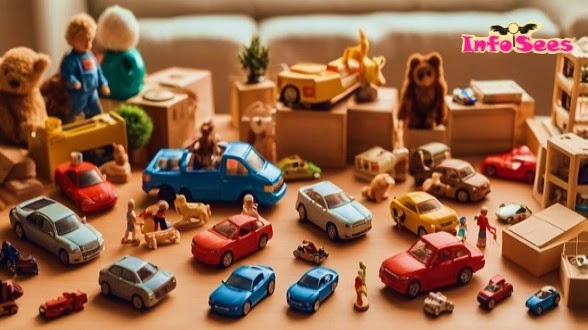
We buy toys for fun, but some toys also help children learn important skills like problem-solving and creativity.
Many kids and collectors want smart, fun, and high-quality toys. To meet this demand, some companies create and sell unique toys—this is called the toy manufacturing business.
It’s a mix of creativity, safety, and smart production to make fun and educational toys for all ages.
Let's find out what Toy Manufacturing Business is?

Toy Manufacturing Business Introduction?
Toy manufacturing involves the production and creation of toys for children of all ages. These toys come in various forms, including action figures, dolls, puzzles, educational toys, and outdoor play items.
With the increasing demand for both traditional and tech-based toys, the market continues to grow, presenting numerous opportunities for business owners.
The toy manufacturing industry is divided into various segments, ranging from small-scale businesses that produce artisanal or custom toys, to large factories that mass-produce toys for global retailers.
Innovations in technology, design, and materials also continue to play a major role in shaping this business.
How To Earn Money in Toy Manufacturing Business?
Selling Direct to Consumers (B2C):
Retail Sales:
One of the most direct methods of making money in the toy manufacturing business is to sell toys directly to consumers.
You can establish your brand, sell online through platforms like Amazon or your website, or set up a physical retail store.
Online Marketplaces:
Platforms like Etsy and eBay can be ideal for selling custom-made or niche toys, allowing entrepreneurs to target specific demographics.
By focusing on a unique product, such as eco-friendly or educational toys, you can cater to a growing market of conscious parents and caregivers.
Wholesale (B2B):
Selling toys in bulk to retailers or large stores is another profitable monetization method. Establishing partnerships with toy retailers, department stores, or online marketplaces allows your business to reach a wider audience, while also benefiting from large orders and repeat business.
Distribution Channels:
You may need to set up a distribution network, which may include establishing warehouses or partnering with logistics companies to manage deliveries and reach large-scale buyers.
Licensing:
Licensing is the most profitable route for established toy manufacturers.
By licensing characters from popular franchises, movies, or cartoons, toy manufacturers can develop toys based on well-known intellectual property (IP), like action figures from superhero movies or plush toys from animated series.
Licensing offers a steady stream of revenue from the sale of these branded toys.
Custom & Niche Toys:
If you can attract a niche audience with unique or custom-designed toys, you can charge a premium price for your products.
For example, making eco-friendly toys, educational toys for children with learning disabilities, or custom-made toys can allow you to capture niche markets willing to pay more for specialty items.
Who Can Start Toy Manufacturing Business?
Creative thinkers:
People who enjoy designing fun and useful toys.
Entrepreneurs:
Anyone interested in starting a business and turning ideas into products.
Engineers and designers:
Those with skills in making safe and smart toy designs.
Moms, dads, and teachers:
People who understand what kids enjoy and need.
Anyone with passion:
If you love toys and want to build something meaningful, you can start!
How To Start a Profitable Toy Manufacturing Business?
Starting a toy manufacturing business requires strategic planning, investment, and understanding of the production process.
Here is a step-by-step guide to help you launch your business successfully:
Step 1: Market Research
Before you dive into the manufacturing process, it's important to conduct thorough market research. Understanding consumer demands, competitor analysis, market gaps, and trends in toy preferences will help you make informed decisions about which toys to produce.
Are you focusing on traditional toys, educational products, or interactive tech-based toys? Research your target market preferences and make sure your product aligns with their interests.
Step 2: Develop a Business Plan
A well-thought-out business plan is essential to guide your operations and secure funding if needed.
Your plan should cover:
Product Details:
What type of toys are you manufacturing? What’s unique about them?
Target Audience:
Who are you creating toys for? (age group, interests, location)
Funding Needs:
How much capital do you need to get started?
Revenue Model:
How will you make money (direct sales, B2B, licensing)?
Marketing Strategy:
How will you promote your toys to potential customers?
Step 3: Set Up the Manufacturing Process
The next step is to set up the manufacturing process. This can be done in-house or through outsourcing.
For small-scale operations, you can start by renting a space and purchasing the necessary machinery or collaborating with third-party manufacturers.
Things to consider:
Material Sourcing:
Whether it’s plastic, wood, or fabric, sourcing materials is critical to producing safe, durable toys. Always check for quality and safety standards.
Manufacturing Equipment:
Depending on your toy type, you may need machines for molding, stitching, or assembly. Invest in equipment that will allow you to maintain quality while scaling production.
Labor:
If you plan to scale up, you may need a team to help with the production, packaging, and quality control.
Step 4: Understand Legal Regulations and Safety Standards
Toy manufacturing is heavily regulated to ensure the safety of children.
Manufacturers must obtain a BIS license to use the ISI Mark, demonstrating compliance with these standards. This process involves factory assessments and product testing.
You will need to comply with national and international safety standards and regulations, such as ASTM F963 (U.S.), EN71 (Europe), and ISO 8124 (International).
These guidelines ensure that toys are non-toxic, durable, and free from sharp edges or small parts that could be a choking hazard.
It's also important to get your products certified by appropriate authorities.
Step 5: Branding and Marketing
Effective branding and marketing are essential to distinguish your toys in a competitive market. Focus on:
Packaging:
The packaging of your toys should be attractive, informative, and eye-catching. It should also be eco-friendly to appeal to the growing number of environmentally conscious consumers.
Social Media and Online Presence:
Use platforms like Instagram, Facebook, and YouTube to showcase your toys.
Engaging content such as unboxing videos or playtime demonstrations can attract parents and children to your products.
Collaborations & Sponsorships:
Partner with influencers or bloggers in the parenting niche to boost your visibility and credibility.
Step 6: Establish Sales Channels
Set up online and offline sales channels to ensure your toys reach your target customers. If you’re just starting, online platforms may be the most cost-effective way to reach a global audience.
Over time, you can consider expanding into brick-and-mortar retail stores, toy chains, or even specialty stores.
Step 7: Monitor Growth and Scaling
As your business grows, keep an eye on customer feedback, trends, and opportunities for new toy designs.
You can increase production or diversify your product line to suit different age groups or markets.
Types of Toy Manufacturing Business?
There are several types of toy manufacturing businesses, depending on the scale, target market, and type of toys produced.
Here are a few types:
Custom Toy Manufacturers:
Creating unique, personalized toys for special events, such as birthdays or holidays.
Eco-Friendly Toy Manufacturers:
Specializing in toys made from sustainable materials, like wood, organic cotton, or recycled plastic.
Educational Toy Manufacturers:
Producing toys that enhance learning, such as puzzles, STEM kits, or board games.
Branded or Licensed Toy Manufacturers:
Focusing on toys tied to popular characters or franchises, such as superheroes or animated movies.
Tech-Based Toy Manufacturers:
Creating electronic or interactive toys that combine play with technology, such as robotic toys or augmented reality games.
Toy Manufacturing Business Successful Tips
Prioritize Safety:
Always adhere to safety standards to avoid product recalls and lawsuits.
Innovate:
Keep an eye on emerging trends, such as eco-friendly materials, tech toys, or interactive play to stay ahead of the competition.
Market Smartly:
Leverage social media to create a buzz about your toys and engage directly with customers.
Quality Control:
Ensure every toy meets your quality standards by establishing a strong quality control process.
Understand Your Audience:
Know the preferences, age, and needs of your target market to design toys that appeal to them.
Knowledge and Considerations You Need to Know
Regulations:
Be aware of international and local regulations regarding toy safety, including materials used, labeling, and packaging.
Technology:
Stay updated with the latest technology trends that can influence toy designs, such as augmented reality or AI in toys.
Cost Management:
Keep your production costs under control by finding cost-effective materials, optimizing labor, and streamlining processes.
Intellectual Property (IP):
Protect your designs through patents, trademarks, or copyrights to safeguard your creative work.
Related Blog Post Topics
Coming soon.
Conclusion
The toy manufacturing business offers immense opportunities for creativity and growth. By following the right steps, understanding market demands, and focusing on quality and safety, you can create a profitable and sustainable business.
Whether you choose to start small or go big, the key to success lies in innovation, branding, and a deep understanding of your customer’s needs.
Frequently Asked Questions (FAQs)
1. Is this a good career?
Yes! Making toys is fun and meaningful. If you enjoy being creative and making kids happy, it’s a great career choice.
2. What is the women’s career path, and why is it important?
Women are important in toy making. They bring fresh ideas to design, marketing, and more. Their role helps create toys every child can enjoy and relate to.
3. What are the career opportunities?
There are many jobs—designing, making, testing, selling, and improving toys. You can also work on new ideas, eco-friendly products, and quality control. There's something for every skill!
Disclaimer
This blog post is for general information, awareness, knowledge and educational purposes only. Always, it is better to check the latest updates and do more research and consult experts to get complete details. The author and publisher do not assume any responsibility or liability for any actions taken based on the information provided in this blog post.
If you find any mistake or error in this article, please let us know and also give suggestions to correct it.
Thank you for coming.
See you soon in another part.






Post a Comment
Post a Comment